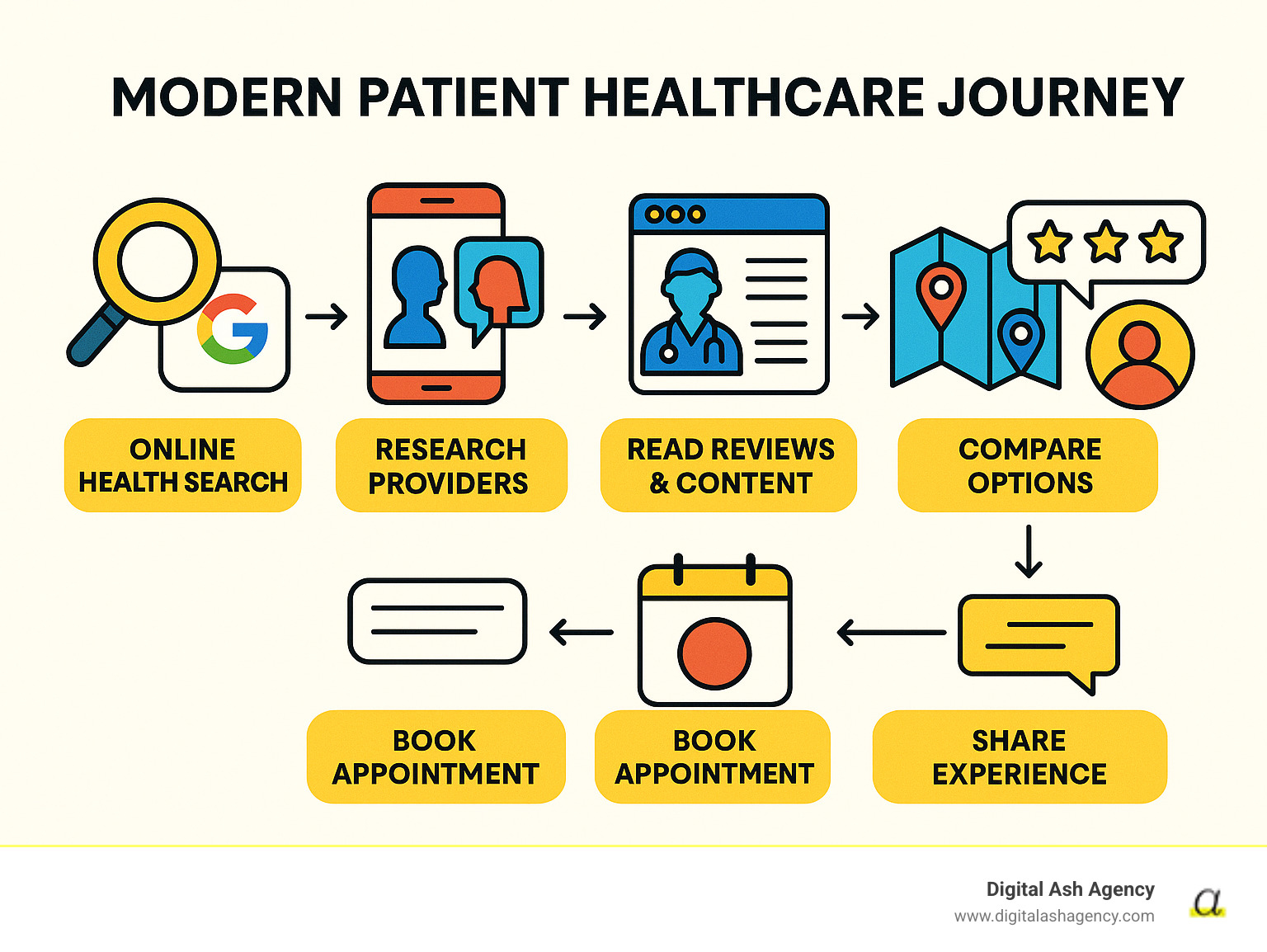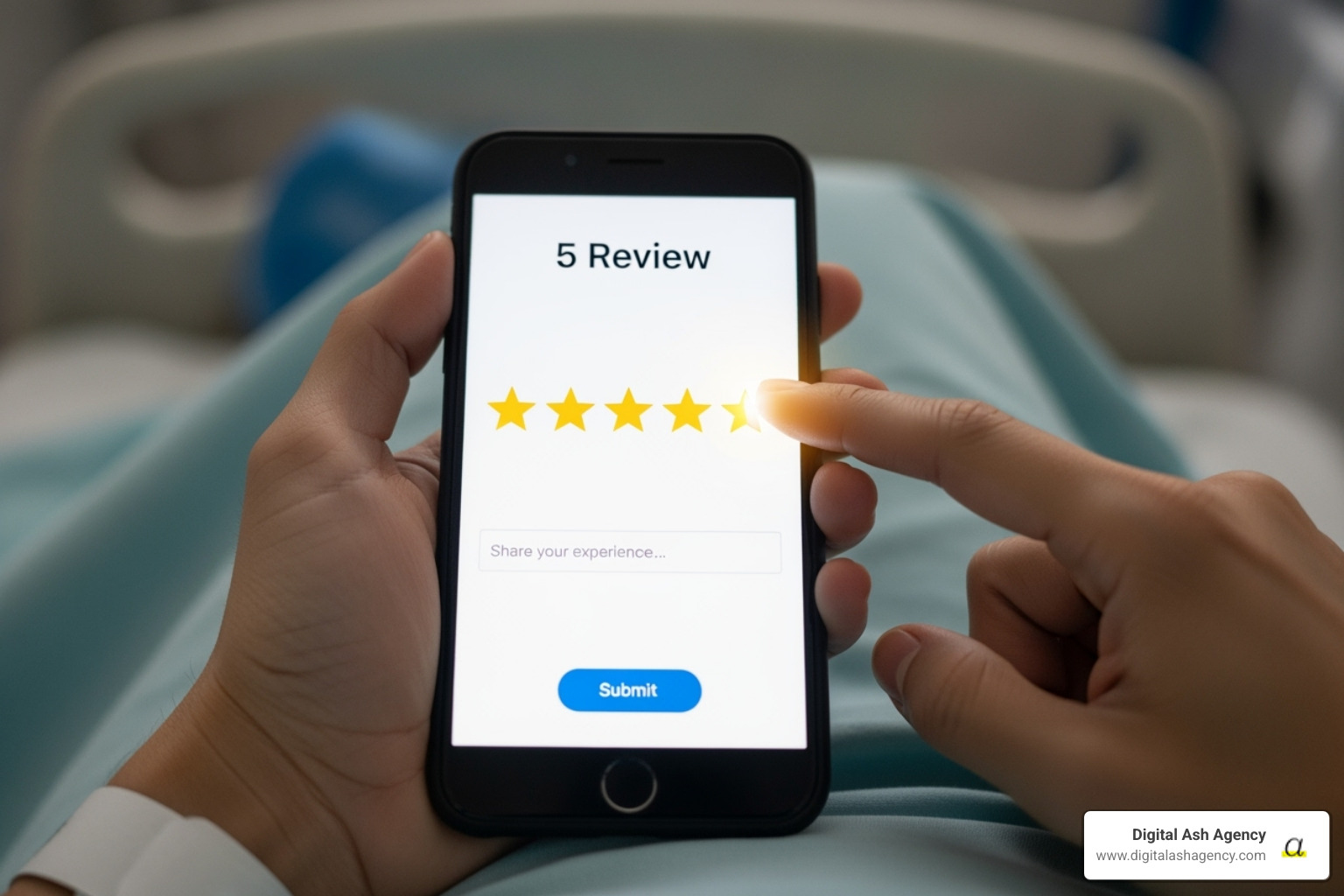
Why Smart Healthcare Advertising Ideas Matter More Than Ever
Healthcare advertising ideas are no longer optional. With telehealth, retail clinics, and urgent-care chains on every corner, patients have more choices than ever and decide in seconds whom to trust.
Quick Healthcare Advertising Ideas for Immediate Impact:
- Optimize your Google Business Profile – Appear in local search results
- Create educational video content – Build trust and authority
- Target high-intent search ads – Reach patients actively seeking care
- Use interactive patient quizzes – Generate qualified leads
- Build physician referral networks – Leverage Doximity and local groups
- Implement geofencing ads – Target patients near your practice
- Host community health workshops – Engage locals and build trust
- Focus on patient reviews – Build social proof and credibility
Modern healthcare marketing succeeds when it’s patient-centric, educational, and accessible. More than 1 billion health questions hit Google every day, and most patients refuse to drive more than 15–20 miles for routine care—so your local digital footprint must be rock solid.
I’m Ashley Gay, founder of Digital Ash Agency. My team has helped practices generate six-figure revenue in their first 90 days—even under strict non-compete agreements—by deploying compliant, high-impact campaigns like the ones in this guide.

Building Your Digital Foundation: SEO and Local Search Dominance
Your digital presence is your practice's front door. When patients search for care online, you need to be the first result they find, not buried on page three of Google.
Healthcare advertising ideas start with being findable. If patients can't find you online, they can't book an appointment. Building a strong SEO foundation and dominating local search is survival in today's competitive market.
Most patients won't drive more than 15-20 miles for routine care, especially in busy urban areas. This makes local SEO your secret weapon. When someone searches "family doctor near me" at 11 PM with a sick child, you want your practice to appear first.
Your website needs to load quickly on mobile devices, provide clear information about your services, and make it ridiculously easy for patients to book appointments. Every page should guide visitors toward one goal: becoming your patient.
We help new practices build this crucial digital foundation. Our approach focuses on fundamentals that move the needle, not flashy tactics that waste your budget. More info about our SEO services for New Healthcare Practices
Master Local Search with Google Business Profile (GBP)
Your Google Business Profile is your most powerful free marketing tool. It's how you appear in Google Maps and those coveted top three local search results. Get this right, and patients will find you before they even know your competitors exist.
Think of your GBP as your digital storefront. Every section needs to be complete and compelling. Your Name, Address, and Phone number (NAP) must be identical everywhere online - Google notices inconsistencies and punishes them.
Upload high-quality photos of your clinic, your team, and even create a virtual tour. Patients want to see where they'll be receiving care. A warm, welcoming photo of your waiting room can ease anxiety before they even walk in.
The Q&A section is pure gold for local SEO. Answer common questions patients ask, and use location-specific keywords naturally. Instead of just "pediatric dentist," try "best pediatric dentist in downtown Springfield" in your business description.
Patient reviews make or break your local search ranking. Google sees reviews as fresh, relevant content that signals your practice is active and trusted. The more recent, genuine reviews you have, the higher you'll rank.
Here's what many practices miss: responding to reviews boosts your visibility too. When you reply to patient feedback, you're creating more content for Google to index while showing potential patients you actually care about their experience.
Optimize Your Website to Convert Visitors into Patients
A beautiful website that doesn't convert visitors into patients is like a gorgeous waiting room that nobody can find. Your website needs to work as hard as you do.
Mobile-first design isn't optional anymore. Over 60% of healthcare searches happen on phones, often late at night when patients are worried about symptoms. If your site looks broken on mobile, they'll find a practice whose site works perfectly.
Page speed can make or break patient conversions. If your website takes more than three seconds to load, potential patients will hit the back button faster than you can say "appointment available." An SEO audit will quickly reveal what's slowing down your site and hurting your search rankings.
Every page needs a clear call-to-action. "Schedule Online," "Call Now," or "Get Directions" buttons should be obvious and clickable. Don't make patients hunt for ways to contact you.
Your service pages need to answer the questions patients are actually asking Google. Instead of medical jargon, use the words patients use when they search. "Tooth cleaning" gets more searches than "prophylaxis."
HIPAA compliance isn't just about avoiding fines - it builds trust. Patients need to feel confident their information is secure when they fill out online forms or request appointments through your website.
Regular website audits catch problems before they cost you patients. What worked last year might be hurting your rankings today as Google updates its algorithms.
Cultivate Online Reviews and Manage Your Reputation

Patient reviews are the modern version of asking your neighbor for a doctor recommendation. The difference? These recommendations are public, permanent, and influence hundreds of potential patients.
Positive reviews do more than make you feel good - they're social proof that turns website visitors into scheduled appointments. When someone sees dozens of five-star reviews praising your bedside manner and short wait times, booking becomes an easy decision.
The key is making review requests feel natural, not pushy. Train your staff to say something like, "If you were happy with your visit today, we'd really appreciate if you could share that online to help other patients find us."
Responding to feedback - both positive and negative - shows you're engaged and care about patient experience. A thoughtful response to a negative review often impresses potential patients more than a dozen five-star reviews with no replies.
Don't panic over negative reviews. They're opportunities to demonstrate your professionalism and commitment to improvement. A sincere apology and explanation of how you've addressed the issue can actually build trust with future patients.
The entire patient experience affects your review generation. From how quickly your phone gets answered to how comfortable your waiting room feels, every touchpoint influences whether patients want to recommend you to others. The importance of the patient experience
Engaging Patients with Content and Social Media
Here's where the magic really happens. Once your digital foundation is rock-solid, you get to focus on what healthcare is truly about: connecting with people. Content marketing and social media aren't just buzzwords - they're your chance to build genuine relationships with patients before they even walk through your door.
Think about it this way: patients are already searching for health information online. They're worried, curious, and looking for answers. By creating valuable content, you're not just implementing smart healthcare advertising ideas - you're becoming the trusted voice they turn to when they need guidance. See examples of our work
Become a Trusted Resource with Educational Blog Content
Every single day, people search Google with more than 1 billion health-related questions. That's not a typo - billion with a "b." In fact, 5% of all Google searches are health-related. Your patients are out there right now, typing questions into their phones at 2 AM because they can't sleep.
This is your golden opportunity to be there for them.
Blogging gives you the perfect platform to address those midnight worries and daytime concerns. When you write about common health issues in simple, easy-to-understand language, you're doing something powerful - you're building trust before patients even meet you.
Take one of our rheumatology clients, for example. They wrote a detailed post explaining the difference between osteoarthritis and rheumatoid arthritis symptoms. Nothing fancy, just clear, helpful information. That single post generated over 107,000 views because it answered exactly what people were searching for.
The best part? This content keeps working for you long after you publish it. You can repurpose your blog posts for email newsletters, keeping your existing patients engaged with monthly health tips or updates about new services. It's like having a conversation with hundreds of patients at once.
Harness the Power of Video Marketing

Here's a statistic that might surprise you: 33% of consumers watch YouTube videos before they even think about calling a doctor. And get this - YouTube is the second largest search engine after Google itself.
Video marketing isn't just trendy; it's essential. There's something about seeing a real person explain things that builds instant trust. When patients can watch you discuss a procedure or answer common questions, you stop being just another name on a website. You become a real person they feel like they already know.
The magic happens when you keep it simple. Film your physicians explaining procedures in everyday language. Create short videos answering the questions you hear most often in your office. Patient testimonials in video format are absolute gold for building credibility - nothing beats hearing a real person share their positive experience.
Don't worry about Hollywood-level production. Authenticity beats perfection every time. Just make sure to add your practice logo and consistent branding to your videos. Then share them everywhere - your website, email newsletters, and social media platforms. A few simple video SEO techniques like proper descriptions and tags will help people find your content when they need it most.
Connect with Your Community on Social Media
Social media gets a bad rap sometimes, but when used thoughtfully, it's an incredible tool for building genuine connections with your community. Facebook and LinkedIn offer unique ways to show the human side of your practice and build real patient loyalty.
Facebook is particularly powerful because 74% of high-income earners use the platform. It's perfect for sharing those educational blog posts you're creating, giving behind-the-scenes glimpses of your practice, and building a sense of community among your patients.
The key to social media success in healthcare is finding that sweet spot between being personable and maintaining professionalism. Share educational content, celebrate your team, and engage authentically with your community. Just remember that HIPAA considerations are always paramount - keep conversations general and educational, never discussing specific patient information.
Building community on social media takes time, but the relationships you create are worth their weight in gold. When patients feel connected to your practice through social media, they're more likely to stay loyal and refer their friends and family.
Proactive Outreach: Smart Healthcare Advertising Ideas and Referral Building
While organic strategies build a strong foundation, proactive outreach via paid ads and referral building accelerates growth. This is where impactful healthcare advertising ideas come into play for established practices looking to expand. Marketing services for Established Healthcare Practices
Attract High-Intent Patients with Search Ads
When someone searches for "knee pain treatment" or "dentist near me" on Google, they have high intent. This is where Pay-Per-Click (PPC) advertising, specifically Google Ads, shines. It allows us to place your practice directly in front of patients actively seeking your services, often at the moment they are ready to book an appointment.
Paid media for dental practices averages a 9.83% conversion rate, with 5-10% being a good Google Ads benchmark. With 70,000 health-related searches per minute on Google, these ads are essential for driving new patient appointments in 2025. We use AI-powered campaigns like Performance Max and Smart Bidding to optimize ad spend and maximize conversions. Thorough keyword research, focusing on long-tail keywords and location extensions, ensures your ads reach the right people.
Innovative Healthcare Advertising Ideas for Local Targeting
Beyond traditional search ads, there are innovative ways to target potential patients locally.
- Geofencing Ads: This exciting tactic for 2025 targets patients in specific geographic areas, even outside a competitor's office. Uniquely, it can track actual patient visits, not just online conversions. For example, you could target local gyms for sports medicine services or new parents visiting pediatrician offices for your family practice.
- Interactive Quizzes: A women's health facility focusing on menopause treatment used a quiz to deliver ideal leads for hormone replacement therapy. Quizzes can pre-qualify leads, educate patients, and capture valuable contact information.
- Community Event Sponsorships: Sponsoring local health fairs, school sports teams, or charity runs can build goodwill and brand awareness within your community.
- Out-of-the-Box Themes: To stand out from the typical "smiling doctors" and "compassionate care" approaches, consider creative ad campaign themes that engage and inform. Consider themes like:
- "Health Myth Busters": Debunk common health misconceptions with engaging visuals and quick facts.
- "Ask a Doc Live Q&A": Host live online sessions where your physicians answer community health questions.
- "Your Health Journey": Share patient success stories that focus on the transformative power of care, not just the illness.
- "Behind the Scenes": Offer a glimpse into the daily life of your practice, showcasing your team's dedication.
- "Wellness Challenges": Run short online challenges (e.g., "30-Day Hydration Challenge") to promote healthy habits and engage your audience.
- "Local Health Spotlight": Partner with local businesses or community groups to promote overall wellness in your area.
Build a Strong Referral Network with Physician Outreach
Referral marketing is a cornerstone of growth for many medical practices. Building strong relationships with referring physicians can provide a steady stream of high-quality patients.
We recommend dedicating resources to physician liaisons or staff members focused on nurturing these connections. LinkedIn Sales Navigator can be an invaluable tool here, allowing you to connect with local physicians and referral coordinators, especially as post-COVID networking has shifted.
Beyond external referrals, effective internal communication is a top marketing strategy. Communication errors cause nearly a third of medical malpractice suits, showing how vital clear communication is for patient experience and outcomes. Fostering strong internal and external communication builds a robust referral network that benefits everyone. Communication errors study
Measuring Success and Ensuring Compliance
Think of healthcare advertising ideas like prescriptions - they need careful monitoring to ensure they're working effectively and safely. You wouldn't prescribe medication without tracking patient outcomes, and the same principle applies to your marketing efforts. Success in healthcare marketing requires both measuring what's working and staying within the strict guidelines that protect your patients and your practice.
The healthcare marketing landscape comes with unique challenges that other industries simply don't face. Every campaign, every piece of content, and every patient interaction must balance effectiveness with compliance. It's like walking a tightrope - but with the right approach, you can achieve remarkable results while maintaining the highest ethical standards.
Navigating HIPAA and Ethical Marketing Considerations
Healthcare marketing operates in one of the most regulated environments imaginable. Between HIPAA, FDA guidelines, and various state regulations, it can feel overwhelming. But here's the thing - these rules exist for good reason, and working within them actually makes your marketing more trustworthy and effective.
Patient privacy is absolutely non-negotiable. Never use Protected Health Information (PHI) in your marketing materials without explicit written consent. This includes patient testimonials, before-and-after photos, or any specific medical details. Even when patients eagerly offer to share their stories, proper consent forms must be completed first.
Data security extends beyond your clinical systems to every marketing platform you use. Whether it's your website analytics, email marketing software, or social media management tools, everything must meet stringent security standards. One data breach can devastate both your reputation and your bank account.
Avoiding misleading claims is crucial for maintaining trust. Healthcare consumers are particularly vulnerable, and they deserve honest, accurate information. This means no exaggerated promises, no guaranteed outcomes, and no cherry-picked statistics that paint an unrealistic picture.
The goal should always be ethical marketing that educates, informs, and builds genuine trust. When you focus on helping patients make informed decisions rather than just driving conversions, you create lasting relationships that benefit everyone involved.
Use Data to Measure and Improve Your Campaigns
Here's a sobering statistic: only 28% of healthcare marketers consistently optimize their content marketing strategy. That means 72% are essentially flying blind, missing opportunities to improve their results and better serve their patients.
Google Analytics and Google Search Console are your best friends for understanding how patients interact with your online presence. These tools show you which pages patients visit most, how long they stay, and where they drop off. More importantly, they reveal which content resonates most with your audience.
Conversion tracking tells the real story of your marketing success. It's not enough to know that people visit your website - you need to know how many book appointments, call your office, or take other meaningful actions. This data helps you understand which healthcare advertising ideas actually drive patient growth.
Key Performance Indicators (KPIs) should align with your specific goals. Are you focused on new patient acquisition? Track cost per new patient and lifetime value. Want to improve patient retention? Monitor email open rates and appointment no-show rates. The metrics that matter most depend on what you're trying to achieve.
A/B testing might sound technical, but it's really just comparing two versions of something to see which works better. Test different headlines on your ads, try various call-to-action buttons on your website, or experiment with different email subject lines. Small changes can lead to significant improvements.
80% of consumers want personalized experiences from the brands they interact with. Data allows you to deliver exactly that, creating marketing messages that speak directly to your patients' needs and concerns. Continuous improvement through data analysis ensures your marketing efforts become more effective over time, delivering better results for both your practice and your patients.
Frequently Asked Questions about Healthcare Marketing
Let's tackle the questions we hear most often from healthcare providers who are ready to grow their practices but aren't sure where to start. These answers come from real experience helping practices steer everything from tight budgets to complex compliance requirements.
What's the most important first step in marketing a new medical practice?
If you're starting a new practice, your first priority should be local SEO and getting your Google Business Profile set up properly. Think of it this way - when someone has knee pain at 2 AM, they're going to Google "orthopedic doctor near me," not flip through a phone book.
Your Google Business Profile is like your digital storefront. It's how you show up in Google Maps and those coveted top three local search results. Without this foundation, you're essentially invisible to the 70,000 people searching for health information every minute on Google.
The beautiful thing about focusing on local search first is that it builds your foundational online presence while ensuring patients can find you both online and when they're driving around your neighborhood looking for care. It's the bridge between digital marketing and real-world foot traffic.
How can I market my practice on a small budget?
Small budget doesn't mean small results - it just means being smart about where you invest your time and energy. The most effective healthcare advertising ideas for tight budgets focus on organic strategies that build momentum over time.
Start with content creation. Write blog posts answering the questions your patients ask most often. Create simple videos explaining common procedures or health tips. This positions you as a trusted expert while improving your search rankings.
Next, perfect your on-page SEO. Make sure your website loads quickly, works perfectly on phones, and includes the keywords your patients are actually searching for. Spend time fully optimizing your Google Business Profile - add photos, answer questions, and keep your information current.
Finally, actively encourage patient reviews. A genuine five-star review from a happy patient is worth more than expensive ads. These organic strategies require more time than money, but they create lasting results that compound over time.
How do I ensure my advertising is HIPAA-compliant?
HIPAA compliance in marketing comes down to one golden rule: never use Protected Health Information (PHI) without explicit written consent. This means no patient names, specific medical conditions, or any details that could identify someone linked to their health information.
When you want to share patient success stories or testimonials, always obtain written consent first. Create a clear form that explains exactly how you'll use their story and where it will appear. Even if a patient enthusiastically offers to share their experience, protect yourself and them with proper documentation.
Use secure platforms for any data collection, whether that's contact forms on your website or email marketing tools. Make sure any third-party services you use are HIPAA-compliant and will sign a Business Associate Agreement.
The key is partnering with marketing experts who understand healthcare regulations inside and out. At Digital Ash Agency, we've helped practices steer these compliance challenges while still creating compelling marketing that attracts patients. We know how to walk that fine line between engaging marketing and bulletproof compliance, so you can focus on what you do best - caring for patients.
Conclusion
The healthcare landscape has transformed dramatically. Patients now have more choices than ever, from telehealth options to retail clinics offering convenient care. In this new reality, healthcare advertising ideas aren't just helpful – they're essential for survival.
The practices that thrive understand one crucial truth: effective marketing builds genuine relationships. It's not about flashy ads or empty promises. It's about being there when patients need you most, providing valuable information when they're searching for answers, and creating trust through authentic engagement.
Throughout this guide, we've explored strategies that work – from mastering your Google Business Profile to creating educational content that positions you as a trusted authority. We've shown you how to harness the power of video marketing, build strong referral networks, and use smart advertising to reach patients with high intent.
The key is taking a patient-centric approach that puts their needs first. When you focus on solving problems, answering questions, and making healthcare more accessible, the marketing takes care of itself. Patients can sense authenticity, and they reward it with their trust and loyalty.
Data-driven decisions ensure you're not just throwing money at marketing hoping something sticks. By measuring what works and continuously improving, you build campaigns that deliver real results – more appointments, stronger relationships, and sustainable growth.
At Digital Ash Agency, we've seen practices transform their futures by implementing these strategies thoughtfully and consistently. We understand the unique challenges healthcare providers face, especially when navigating competitive markets or restrictive agreements.
Ready to take your practice to the next level? We're here to help you implement these proven strategies and create a marketing approach that truly reflects your commitment to patient care.
Ready to grow your practice? Contact us for a free assessment!







